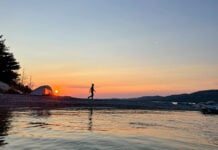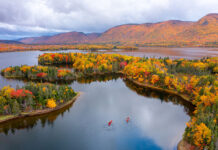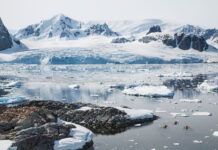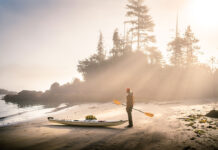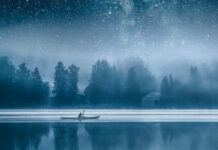I’ve been settling in for winter by picking up a musty hardcover, Seekers of the Horizon: Sea Kayaking Voyages from Around the World. California paddler Will Nordby edited the 11 stories within and released the book 30 years ago.
Nordby took his inspiration from an even older book, Folbot Holidays by Jack Kissner, published in the 1940s, which he found in a used bookstore when he was a new kayaker. “I like to think my anthology represents a passing of the torch for the current generation of kayakers,” Nordby mused at the time. “Perhaps some future generation might discover it in a used-book store.”
Ha! Nordby could not foresee my generation would be far more likely to instead discover his book thanks to an Internet search algorithm. Then have it shipped across the continent via a reseller on Amazon.com.
Much has changed since the time of Nordby’s stories—the opening tale describes an emergency kit with “dimes for the telephone”—but I’m amazed by how much the kayaking experience has not, even as our technology has advanced.
To arrive at this conclusion, first I had to actually read the book. I want to say I eagerly devoured Seekers the second it appeared in my mailbox. Instead, I treated it like radioactive Kryptonite. It got stuffed into my wardrobe, buried in a pile of clothes. Then it moved to my bedside table, then to my desk, collecting dust.
All the while, I was busy keeping away from a sea kayaking book of my own. This year, I had resolved to finally write about my 80-day kayak trip down Canada’s West Coast way back in 2002. After 17 years of gestation, I figure the thoughts should be about the right vintage now.
This might be surprising coming from the writer of a column about kayaking in a paddling magazine, but the very idea of reading a book—let alone writing one—about kayaking struck me as totally dull. I know how all these stories go, including my own. There’s some bad weather, minor mishaps. Some cold and discomfort. Lots of references to meals eaten. Clumsy attempts to describe the indescribable landscape. And then some canned revelation about how meaningful it all was. Ho-hum. I just remembered I have laundry to do.
Months later, when I finally launched into reading the first story about Paul Kaufmann’s regular paddles in San Francisco Bay, I was enchanted with an insight into a kayak journey which happened 50 years ago. Surprisingly antiquated and yet refreshingly familiar.
Kaufmann uses a wooden paddle, pigskin gloves and rests his feet on a piece of sheepskin and repurposed conveyor belt. He ties a plastic dog leash to his coffee thermos so he can fetch it from deep inside his kayak, presumably before bulkheads and day hatches arrived on the West Coast. He’s the guy who packs dimes for the telephone. There was hardly anybody paddling under the Golden Gate back then. And yet, every feeling he describes—gradually growing comfortable with the water and, over time, being changed by it—is familiar. He could be writing today. He could be a fellow paddler, a friend.
Reading an actual book in public, I stand out.
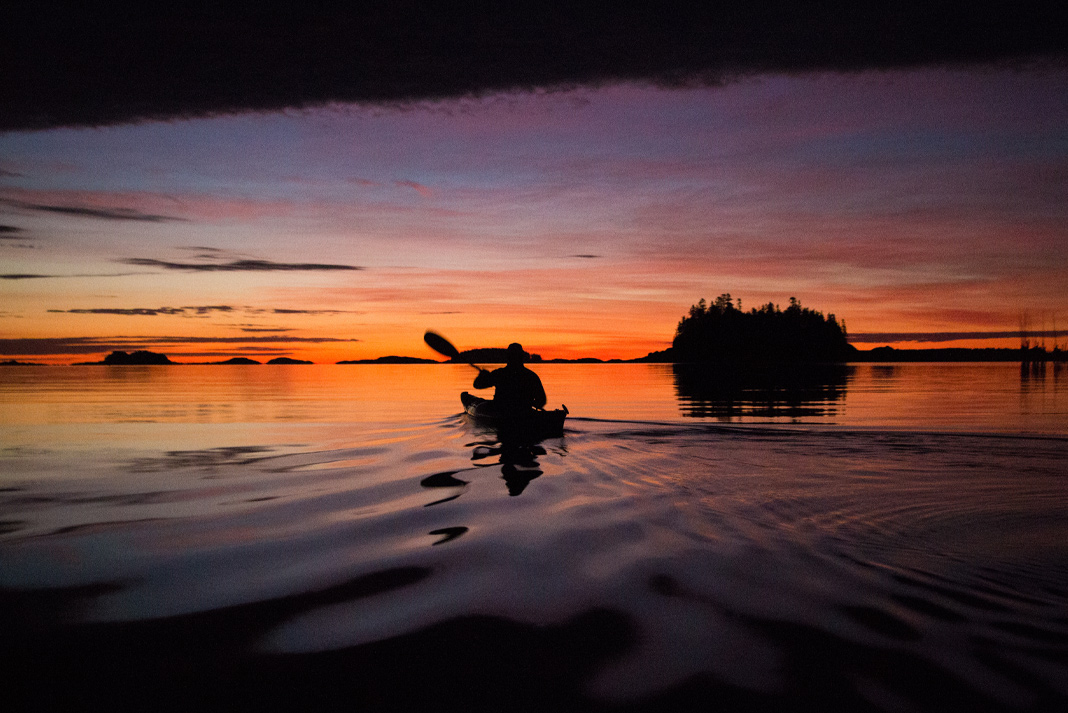
“What is that thing?” someone looks up from their phone to ask, and I have to wonder if they’re serious.
The pain of reading nowadays is palpable, like the slowness of walking when used to driving. Or the difficulty of running when out of shape. It’s not unlike the beginning of a trip, feeling a little bit uncomfortable in the new element, and shocked by the slow pace.
“Maybe in the age of the smartphone, reading a book about kayaking is a revolutionary act,” I suggest to my wife one evening. “Maybe writing a book about kayaking is a revolutionary act—maybe kayaking itself is a revolutionary act!”
“Oh, come on!” she scoffs in a voice she reserves for making fun of dumb things men say. “If you said this in public, people would throw tomatoes at you!”
Okay, revolutionary may be too strong a word. But kayaking is certainly going against the grain. Maybe in this Anthropocene epoch of extinction, the time to do things slowly is endangered too, succumbing to the destruction of mental habitat, the psychological wildness razed by chronic overstimulation.
Once I started thinking in terms of revolution, I saw it everywhere. To all the writers in Seekers, kayaking is a countercultural act. It always has been.
In Matthew Futterman’s recent book Running to the Edge, about the history of American distance running, he notes we forget about the sport’s rebellious roots. Back in the ‘60s and ‘70s, normal people didn’t exercise, and distance runners were a misfit band of hippies, borderline mystics chasing an elusive natural high at the limits of human endurance.
The kayaking boom was part of the same cultural moment, the one which gave rise to Nordby’s book, full of renegades battling the perceived dangers of going to sea in a tiny boat. Like firecracker Audrey Sutherland who half-swam and half-paddled surf-battered Molokai in a mail-order inflatable. “I was figuring out my systems as I went along,” she writes. “In all my reading about the sea, there wasn’t any guideline for this kind of expedition. It was all trial and error, mostly error.”
These adventures happened before kayaks were widely available, before Paddling Magazine and the Internet. Few of these paddlers had much outside knowledge of what anyone did before, or the sanctioned way to go about it. They were responding to an inner calling, deep in the human spirit, to go out and be one with the water, to make themselves tiny and vulnerable in the face of nature.
John Bauman tries to reassure the skeptical Icelandic authorities it’s not insane to paddle a kayak around their country. In the 1940s, Susan Meredith has to convince the captain of the government vessel on which she’s working along the Alaskan coast that she’s not nuts to purchase one of the local skin kayaks, which marks the beginning of a lifelong passion. Nordby eschews the plush tourist cruise to Glacier Bay, opting instead to camp out in the rain, amongst the bears.
Understated but pervasive is the thread of defiance and pride at doing this most unconventional thing, nose-thumbing at the bystander’s judgment that taking to big water in such a small, slow boat is boring or dangerous. “You’re crazy to be out there in that thing,” each writer is told.
Every one of these writers is a rebel paddling against the current of civilization, a free spirit choosing the hard way, choosing challenge, simplicity and smallness over the mainstream default toward the comfortable, easy and safe. This pattern of challenge-seeking forms the tapestry of a meaningful life.
If revelation comes at the end of a kayak trip, or the end of the story, it’s the payoff for doing things the hard way. In these days when there’s too much fighting between those who say we have to give things up and those who refuse, it’s helpful to remember sometimes less is more, and with great challenge comes great reward.
It reminds me of a quote from Bohemian-Austrian poet Rilke in another book I’m plodding through: “If only we arrange our lives in accordance with the principle which tells us we must always trust in the difficult, then what now appears to us as the most alien will become our most intimate and trusted experience.”
Choosing challenge, simplicity and smallness in the face of modern comforts is the kayaker’s most counterculture act. | Featured photo: Harry Daley



